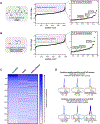Identification of Protein Targets of S-Nitroso-Coenzyme A-Mediated S-Nitrosation Using Chemoproteomics
- PMID: 38159293
- PMCID: PMC11154738
- DOI: 10.1021/acschembio.3c00654
Identification of Protein Targets of S-Nitroso-Coenzyme A-Mediated S-Nitrosation Using Chemoproteomics
Abstract
S-Nitrosation is a cysteine post-translational modification fundamental to cellular signaling. This modification regulates protein function in numerous biological processes in the nervous, cardiovascular, and immune systems. Small molecule or protein nitrosothiols act as mediators of NO signaling by transferring the NO group (formally NO+) to a free thiol on a target protein through a transnitrosation reaction. The protein targets of specific transnitrosating agents and the extent and functional effects of S-nitrosation on these target proteins have been poorly characterized. S-nitroso-coenzyme A (CoA-SNO) was recently identified as a mediator of endogenous S-nitrosation. Here, we identified direct protein targets of CoA-SNO-mediated transnitrosation using a competitive chemical-proteomic approach that quantified the extent of modification on 789 cysteine residues in response to CoA-SNO. A subset of cysteines displayed high susceptibility to modification by CoA-SNO, including previously uncharacterized sites of S-nitrosation. We further validated and functionally characterized the functional effects of S-nitrosation on the protein targets phosphofructokinase (platelet type), ATP citrate synthase, and ornithine aminotransferase.
Figures





Similar articles
-
Proteomic and mass spectroscopic quantitation of protein S-nitrosation differentiates NO-donors.ACS Chem Biol. 2010 Jul 16;5(7):667-80. doi: 10.1021/cb100054m. ACS Chem Biol. 2010. PMID: 20524644 Free PMC article.
-
Promotion of S-nitrosation of cysteine by a {Co(NO)2}10 complex.Chem Commun (Camb). 2023 Aug 8;59(64):9774-9777. doi: 10.1039/d3cc02784h. Chem Commun (Camb). 2023. PMID: 37486167
-
Identification of novel S-nitrosation sites in soluble guanylyl cyclase, the nitric oxide receptor.J Proteomics. 2016 Apr 14;138:40-7. doi: 10.1016/j.jprot.2016.02.009. Epub 2016 Feb 18. J Proteomics. 2016. PMID: 26917471 Free PMC article.
-
Proteomic approaches to evaluate protein S-nitrosylation in disease.Mass Spectrom Rev. 2014 Jan-Feb;33(1):7-20. doi: 10.1002/mas.21373. Epub 2013 Jun 15. Mass Spectrom Rev. 2014. PMID: 23775552 Review.
-
Mechanisms of S-nitrosothiol formation and selectivity in nitric oxide signaling.Curr Opin Chem Biol. 2012 Dec;16(5-6):498-506. doi: 10.1016/j.cbpa.2012.10.016. Epub 2012 Nov 3. Curr Opin Chem Biol. 2012. PMID: 23127359 Free PMC article. Review.
References
-
- Calabrese V; Cornelius C; Rizzarelli E; Owen JB; Dinkova-Kostova AT; Butterfield DA Nitric Oxide in Cell Survival: A Janus Molecule. Antioxidants and Redox Signaling. Mary Ann Liebert, Inc. 140 Huguenot Street, 3rd Floor New Rochelle, NY 10801 USA November 1, 2009, pp 2717–2739. 10.1089/ars.2009.2721. - DOI - PubMed
Publication types
MeSH terms
Substances
Grants and funding
LinkOut - more resources
Full Text Sources

